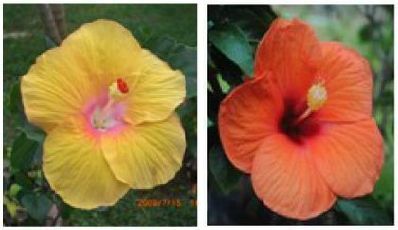VOLUME 6 NUMBER 1 (January to June 2013)

Philipp. Sci. Lett. 2013 6 (1) 039-056
available online: March 8, 2013
*Corresponding author
Email Address: magdalitapm@yahoo.com
Submitted: August 10, 2012
Revised: January 10, 2013
Accepted: January 12, 2013
ARTICLE
Development of hibiscus hybrids 'Womenin Public Service Series II' and propagationstudies on Hibiscus rosa-sinensis 'CynthiaA. Villar'
by Pablito M. Magdalita1* and Reynold B. Pimentel2
1Crop Science Cluster and Institute of Plant Breeding, College of Agriculture,
University of the Philippines Los Baños, 4031 College, Laguna, Philippines
2Del Monte Philippines Inc., Camp Phillips, Bukidnon
University of the Philippines Los Baños, 4031 College, Laguna, Philippines
2Del Monte Philippines Inc., Camp Phillips, Bukidnon
The breeding and selection of hibiscus have beenconducted since 1995 at the breeding nursery of theInstitute of Plant Breeding (IPB), Crop ScienceCluster (CSC), University of the Philippines LosBaños (UPLB), to continuously develop newhybrids. Seven hybrids with unique and new flower traits plussuitable plant growth habit were selected. The seven hybrids,collectively called the 'Women in Public Series II', were namedafter outstanding and dedicated Filipina public servants. Thesehybrids are: i) Hibiscus rosa-sinensis 'Domini M. Torevillas', adark orange (RHCC 28 A) flower with dark red eye zone andlight red blushes radiating to the petals; ii) H. rosa-sinensis'Cynthia A. Villar', an orange (RHCC 28B) flower with red eyezone (RHCC 45B) surrounded by pinkish halo; iii) H. rosa-sinensis'Marilyn D. Marañon', a lemon yellow (RHCC 8 A)flower with white eye zone (RHCC 25 A) surrounded by pinkishhalo; iv) H. rosa-sinensis 'Maria Rosario O. Montejo', a redorange (RHCC 45 B) flower with pinkish red eye surrounded byyellow edges; v) H. rosa-sinensis 'Arlene B. Arcillas', a carminerose (RHCC 52C) flower with cardinal red eye (RHCC 53C); vi)H. rosa-sinensis 'Connie S. Angeles', an orpiment orange(RHCC 25 A) flower with cardinal red eye (RHCC 53 A)surrounded by pinkish halo; and vii) H. rosa-sinensis 'Sylvia P.Lina', a neyron rose (RHCC 56A) flower with magenta eye(RHCC 66A). These hibiscus hybrids have been registered withthe Germplasm and Technology Release and Registration Office(GTRRO) of the IPB-CSC.Propagation studies on Hibiscus rosa-sinensis 'Cynthia A.Villar' were conducted to explore the use of techniques thatcould enhance rapid propagation of the new variety. Among thethree hibiscus varieties tested, the var. 'Wilcox' had significantlythe highest percent success for use as rootstock in comparison tovar. 'Reddy or Not' and 'Petite Peach'. Among the threepropagation methods used, marcotting had significantly thehighest percentage (95.83%) of success in producing asexuallypropagated plants compared to cleft-grafting and budding. Inaddition, marcots treated with Biospark Trichodermasignificantly produced a higher number of adventitious rootsthan marcots treated with the rooting hormone orthe combination of rooting hormone and Biospark Trichoderma.
© 2024 SciEnggJ
Philippine-American Academy of Science and Engineering